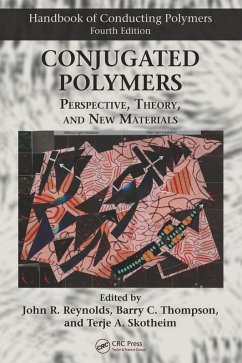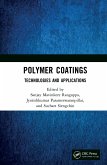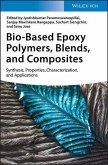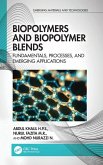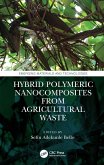Conjugated Polymers
Perspective, Theory, and New Materials
Herausgeber: Reynolds, John R.; Skotheim, Terje A.; Thompson, Barry C.
Conjugated Polymers
Perspective, Theory, and New Materials
Herausgeber: Reynolds, John R.; Skotheim, Terje A.; Thompson, Barry C.
- Gebundenes Buch
- Merkliste
- Auf die Merkliste
- Bewerten Bewerten
- Teilen
- Produkt teilen
- Produkterinnerung
- Produkterinnerung
This book covers perspectives, theory, and new materials involved in conducting polymers. It discusses polymer and materials chemistry, including such topics as polyacetylenes, conjugated ladder polymers, polythiophenes, conjugated polyelectrolytes, and donor acceptor polymers.
Andere Kunden interessierten sich auch für
![Polymer Coatings Polymer Coatings]() Polymer Coatings207,99 €
Polymer Coatings207,99 €![Bio-Based Epoxy Polymers, Blends and Composites Bio-Based Epoxy Polymers, Blends and Composites]() Bio-Based Epoxy Polymers, Blends and Composites118,99 €
Bio-Based Epoxy Polymers, Blends and Composites118,99 €![Poled Polymers and Their Applications to SHG and EO Devices Poled Polymers and Their Applications to SHG and EO Devices]() Seizo MiyataPoled Polymers and Their Applications to SHG and EO Devices247,99 €
Seizo MiyataPoled Polymers and Their Applications to SHG and EO Devices247,99 €![Biocide Guanidine Containing Polymers Biocide Guanidine Containing Polymers]() SivovBiocide Guanidine Containing Polymers259,99 €
SivovBiocide Guanidine Containing Polymers259,99 €![Conducting Polymers for Advanced Energy Applications Conducting Polymers for Advanced Energy Applications]() Conducting Polymers for Advanced Energy Applications214,99 €
Conducting Polymers for Advanced Energy Applications214,99 €![Biopolymers and Biopolymer Blends Biopolymers and Biopolymer Blends]() Abdul Khalil H. P. S.Biopolymers and Biopolymer Blends210,99 €
Abdul Khalil H. P. S.Biopolymers and Biopolymer Blends210,99 €![Hybrid Polymeric Nanocomposites from Agricultural Waste Hybrid Polymeric Nanocomposites from Agricultural Waste]() Hybrid Polymeric Nanocomposites from Agricultural Waste196,99 €
Hybrid Polymeric Nanocomposites from Agricultural Waste196,99 €-
-
-
This book covers perspectives, theory, and new materials involved in conducting polymers. It discusses polymer and materials chemistry, including such topics as polyacetylenes, conjugated ladder polymers, polythiophenes, conjugated polyelectrolytes, and donor acceptor polymers.
Hinweis: Dieser Artikel kann nur an eine deutsche Lieferadresse ausgeliefert werden.
Hinweis: Dieser Artikel kann nur an eine deutsche Lieferadresse ausgeliefert werden.
Produktdetails
- Produktdetails
- Verlag: CRC Press
- 4. Auflage
- Seitenzahl: 678
- Erscheinungstermin: 3. April 2019
- Englisch
- Abmessung: 260mm x 183mm x 41mm
- Gewicht: 1449g
- ISBN-13: 9781138065697
- ISBN-10: 1138065692
- Artikelnr.: 56234164
- Herstellerkennzeichnung
- Libri GmbH
- Europaallee 1
- 36244 Bad Hersfeld
- gpsr@libri.de
- Verlag: CRC Press
- 4. Auflage
- Seitenzahl: 678
- Erscheinungstermin: 3. April 2019
- Englisch
- Abmessung: 260mm x 183mm x 41mm
- Gewicht: 1449g
- ISBN-13: 9781138065697
- ISBN-10: 1138065692
- Artikelnr.: 56234164
- Herstellerkennzeichnung
- Libri GmbH
- Europaallee 1
- 36244 Bad Hersfeld
- gpsr@libri.de
Terje A. Skotheim is the founder of Lightsense and has a successful record in developing new technologies and launching new products in fields as diverse as advanced lithium-sulfur batteries, MEMS devices, photovoltaic cells, and biosensors, through several startups. His research interests have spanned across several disciplines in materials science, including conducting polymers, semiconductors, ion conductors and diamond-like carbon. He has held research positions and co-founded companies in Europe and the US, and was head of the conducting polymer group at DOE's Brookhaven National Laboratory before launching his career as an entrepreneur. He received his B.S. in physics from the Massachusetts Institute Technology and his Ph.D. in physics from the University of California at Berkeley. John R. Reynolds, a native Californian, obtained his B.S. in Chemistry at San Jose State University (1979) followed by his M.S. (1982) and Ph.D. (1984) in Polymer Science and Engineering at the University of Massachusetts. He became interested in the field of conducting and electroactive polymers through a position with the IBM Research Laboratories in the late 1970s. After developing his own research effort at The University of Texas at Arlington (1984-1991), he moved to the University of Florida where he was a Professor of Chemistry and Associate Director of the Center for Macromolecular Science and Engineering until Spring 2012, when his group moved to Georgia Tech where he is a Professor of Chemistry and Biochemistry, and Materials Science and Engineering. He served as Director of the Georgia Tech Polymer Network (GTPN) and is a member of the Center for Organic Photonics and Electronics (COPE) management team. Barry C. Thompson was born in Milwaukee, Wisconsin in 1977 and moved to Gallipolis, Ohio at a young age, where he attended elementary and high school. Barry then attended the University of Rio Grande in Rio Grande, Ohio, where he majored in Chemistry and Physics and minored in Mathematics. After completing his undergraduate studies at Rio Grande, Barry moved to the University of Florida to pursue a Ph.D. in Chemistry with Prof. John R. Reynolds as an NSF Graduate Research Fellow. During his Ph.D. studies, Barry focused on the design and synthesis of electroactive conjugated polymers for electrochromic and photovoltaic applications. Upon completion of his Ph.D. in 2005, Barry moved to Prof. Jean Fréchet's lab at UC Berkeley to further pursue his interests in polymer-based photovoltaics as an ACS-PRF Postdoctoral Fellow. After a three-year stay at Berkeley, Barry moved to the University of Southern California, Department of Chemistry and Loker Hydrocarbon Research Institute as an Assistant Professor of Chemistry. Barry was promoted to Associate Professor with Tenure in 2015.
Perspective and Overview. History of CPs and the HBCP. Perspective on the
CP Physics. Perspective on the CP Chemistry. Theory of Conjugated Polymers.
Polymer and Materials Chemistry. Polyacetylenes. Conjugated Ladder
Polymers. Polythiophenes. Conjugated Polyelectrolytes. Donor Acceptor
Polymers. Direct Arylation. Vapor Phase Polymerization. Conjugated Block
Copolymers. Selenophenes, Tellurophenes, etc. Continuous Flow Processing.
Metal Containing Conjugated Polymers. Boron Containing Conjugated Polymers.
Conjugated Oligomers. n-Type Conjugated Polymers. Photorefractive Polymers.
CP Physics. Perspective on the CP Chemistry. Theory of Conjugated Polymers.
Polymer and Materials Chemistry. Polyacetylenes. Conjugated Ladder
Polymers. Polythiophenes. Conjugated Polyelectrolytes. Donor Acceptor
Polymers. Direct Arylation. Vapor Phase Polymerization. Conjugated Block
Copolymers. Selenophenes, Tellurophenes, etc. Continuous Flow Processing.
Metal Containing Conjugated Polymers. Boron Containing Conjugated Polymers.
Conjugated Oligomers. n-Type Conjugated Polymers. Photorefractive Polymers.
Perspective and Overview. History of CPs and the HBCP. Perspective on the
CP Physics. Perspective on the CP Chemistry. Theory of Conjugated Polymers.
Polymer and Materials Chemistry. Polyacetylenes. Conjugated Ladder
Polymers. Polythiophenes. Conjugated Polyelectrolytes. Donor Acceptor
Polymers. Direct Arylation. Vapor Phase Polymerization. Conjugated Block
Copolymers. Selenophenes, Tellurophenes, etc. Continuous Flow Processing.
Metal Containing Conjugated Polymers. Boron Containing Conjugated Polymers.
Conjugated Oligomers. n-Type Conjugated Polymers. Photorefractive Polymers.
CP Physics. Perspective on the CP Chemistry. Theory of Conjugated Polymers.
Polymer and Materials Chemistry. Polyacetylenes. Conjugated Ladder
Polymers. Polythiophenes. Conjugated Polyelectrolytes. Donor Acceptor
Polymers. Direct Arylation. Vapor Phase Polymerization. Conjugated Block
Copolymers. Selenophenes, Tellurophenes, etc. Continuous Flow Processing.
Metal Containing Conjugated Polymers. Boron Containing Conjugated Polymers.
Conjugated Oligomers. n-Type Conjugated Polymers. Photorefractive Polymers.

